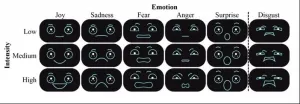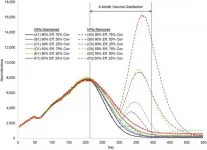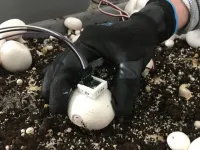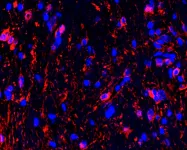(Press-News.org) Popcorn. What would movies and sporting events without this salty, buttery snack? America's love for this snack goes beyond these events. We consume 15 billion quarts of popped popcorn each year.
When it comes to popcorn, consumers want a seed-to-snack treat that leaves more snacks than seeds when popped. This means when they pop the corn, there shouldn't be many unpopped kernels left in the bowl.
Maria Fernanda Maioli set out to determine the properties affecting popping expansion in popcorn. The team's research was recently published in Agronomy Journal, a publication of the American Society of Agronomy.
"The way kernels expand is a basic, yet very important characteristic of popcorn," says Fernanda Maioli. This is referred to as "expansion ratio."
"Very hard grains burst when heated. This expansion multiplies the initial volume of the grains by more than 40 times. In the case of popcorn, it produces a unique and tasty food."
The major factors that influence popcorn quality are kernel moisture, expansion ratios, and popping ratios. Higher quality popcorn is associated with kernels that expand more. This popped corn has a better texture and softness.
There have been several past studies on the ways popcorn kernel expand. These studies report that popping expansion has a strong association with higher starch content in kernels.
Previous research also shows that popcorn varieties with a thicker protective outer seed coating - have a greater expansion ratio.
Popping ability is also affected by how well the starchy substance inside kernels transfer heat during the popping process. Fernanda Maioli and her team's study measured this performance, which makes this research unique.
"We observed how this heat transfer inside the popcorn kernel relates to the expansion ratio," she adds. "It allowed us to understand how other characteristics may also relate to expansion."
"The purpose of our study was to identify popcorn characteristics related to expansion," says Fernanda Maioli. "This will help us efficiently identify popcorn varieties with good agronomic characteristics as well as good popping quality."
The team evaluated 49 types of popcorn for different traits. The traits included grain yield, kernel length, popping expansion, kernel and protective layer thickness, heat transfer ability, and the amount of protein in kernels.
Then the researchers studied the influence of those characteristics on the popping expansion.
"Our results showed that the thickness of the kernel's outer layer is a key trait for selecting popcorn with greater popping expansion," says Fernanda Maioli.
Understanding which popcorn traits are related to the expansion capacity will help future researchers identify and breed high quality popcorn. Researchers will not need to spend time and money to look at other unrelated characteristics.
The team hopes they can identify relationships between other key traits. Future research will continue to improve the tasty, buttery snack.
INFORMATION:
Maria Fernanda Maioli is a researcher at the State University of Maringá in Brazil.
BEER-SHEVA, Israel...June 2, 2021 - As drones become more ubiquitous in public spaces, researchers at Ben-Gurion University of the Negev (BGU) have conducted the first studies examining how people respond to various emotional facial expressions depicted on a drone, with the goal of fostering greater social acceptance of these flying robots.
The research, which was presented recently at the virtual ACM Conference on Human Factors in Computing Systems, reveals how people react to common facial expressions superimposed on drones.
"There is a lack of research on how drones are perceived and understood by humans, which is vastly different than ground robots." says Prof. Jessica Cauchard together with Viviane Herdel of BGU's Magic Lab, in the BGU Department of Industrial ...
New research from the Georgia Institute of Technology finds that elephants dilate their nostrils in order to create more space in their trunks, allowing them to store up to nine liters of water. They can also suck up three liters per second -- a speed 50 times faster than a human sneeze (150 meters per second/330 mph).
The Georgia Tech College of Engineering study sought to better understand the physics of how elephants use their trunks to move and manipulate air, water, food and other objects. They also sought to learn if the mechanics could inspire the creation of more efficient robots that use air motion to hold and move things.
While octopus use jets of water to move and archer fish shoot water above the surface to catch insects, the Georgia Tech researchers found that elephants ...
Boulder, Colo., USA: Article topics include Zealandia, Earth's newly recognized continent; the topography of Scandinavia; an interfacial energy penalty; major disruptions in North Atlantic circulation; the Great Bahama Bank; Pityusa Patera, Mars; the end-Permian extinction; and Tongariro and Ruapehu volcanoes, New Zealand. These Geology articles are online at https://geology.geoscienceworld.org/content/early/recent.
Mass balance controls on sediment scour and bedrock erosion in waterfall plunge pools
Joel S. Scheingross; Michael P. Lamb
Abstract: Waterfall plunge pools experience cycles of sediment aggradation and scour that modulate ...
CHAPEL HILL, NC - Research published by JAMA Network Open shows how non-pharmaceutical interventions (NPIs) like mask wearing and physical distancing can help prevent spikes in COVID-19 cases as populations continue to get vaccinated. The study, led by Mehul Patel, PhD, a clinical and population health researcher in the department of Emergency Medicine at the UNC School of Medicine, focuses on the state of North Carolina. Similar modeling studies have been used in different states, and can serve as guidance to leaders as they make decisions to relax restrictions and safety protocols.
"The computer simulation modeling allows us to look at multiple factors that play a role in decreasing the spread of COVID-19 as vaccines are ...
PROVIDENCE, R.I. [Brown University] -- By delivering small electrical pulses directly to the brain, deep brain stimulation (DBS) can ease tremors associated with Parkinson's disease or help relieve chronic pain. The technique works well for many patients, but researchers would like to make DBS devices that are a little smarter by adding the capability to sense activity in the brain and adapt stimulation accordingly.
Now, a new algorithm developed by Brown University bioengineers could be an important step toward such adaptive DBS. The algorithm removes a key hurdle that makes it difficult for DBS systems to sense brain signals while simultaneously delivering stimulation.
"We know that there are electrical signals ...
Researchers in Penn State's College of Agricultural Sciences have developed a robotic mechanism for mushroom picking and trimming and demonstrated its effectiveness for the automated harvesting of button mushrooms.
In a new study, the prototype, which is designed to be integrated with a machine vision system, showed that it is capable of both picking and trimming mushrooms growing in a shelf system.
The research is consequential, according to lead author Long He, assistant professor of agricultural and biological engineering, because the mushroom industry has been facing labor shortages and rising labor costs. Mechanical or robotic picking can help alleviate those problems.
"The mushroom industry in Pennsylvania is producing about two-thirds of the mushrooms ...
Older adults with cognitive impairment are two to three times more likely to fall compared with those without cognitive impairment. What's more, the increasing use of pain medications for chronic pain by older adults adds to their falls risk. Risks associated with falls include minor bruising to more serious hip fractures, broken bones and even head injuries. With falls a leading cause of injury for people aged 65 and older, it is an important public health issue to study in order to allow these adults increased safety and independence as they age.
Although elevated risk of falls due to use of pain medication by older adults has been widely studied, less ...
In a study of mice, researchers showed how the act of seeing light may trigger the formation of vision-harming tumors in young children who are born with neurofibromatosis type 1 (NF1) cancer predisposition syndrome. The research team, funded by the National Institutes of Health, focused on tumors that grow within the optic nerve, which relays visual signals from the eyes to brain. They discovered that the neural activity which underlies these signals can both ignite and feed the tumors. Tumor growth was prevented or slowed by raising young mice in the dark or treating them with an experimental cancer drug during a critical period of cancer development.
"Brain cancers recruit the resources they need from the environment ...
Researchers world-wide are focused on clearing the toxic mutant Huntingtin protein that leads to neuronal cell death and systemic dysfunction in Huntington's disease (HD), a devastating, incurable, progressive neurodegenerative genetic disorder. Scientists in the Buck Institute's Ellerby lab have found that the targeting the protein called FK506-binding protein 51 or FKBP51 promotes the clearing of those toxic proteins via autophagy, a natural process whereby cells recycle damaged proteins and mitochondria and use them for nutrition.
Publishing in Autophagy , researchers showed that FKBP51 promotes autophagy through a new mechanism that could avoid worrisome side ...
Despite a name straight from a Tarantino movie, natural killer (NK) cells are your allies when it comes to fighting infections and cancer. If T cells are like a team of specialist doctors in an emergency room, NK cells are the paramedics: They arrive first on the scene and perform damage control until reinforcements arrive.
Part of our innate immune system, which dispatches these first responders, NK cells are primed from birth to recognize and respond to danger. Learning what fuels NK cells is an active area of research in immunology, with important clinical implications.
"There's a lot of interest right now ...





